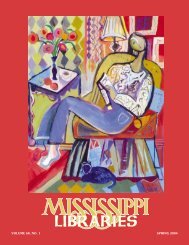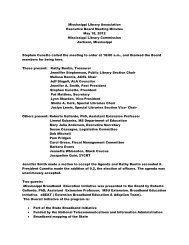PAGE 56 VOL. 75, NO. 2 • SUMMER 2012 MISSISSIPPI LIBRARIESjob backer, nipping press, press boards, anda sewing frame. Preservation Technologies,in Cranberry Township, PA, provided adeacidification spray system. Bill Minterprovided the ultrasonic welder, which wasdelivered from Woodbury, PA. The ultrasonicwelder took about six months fordelivery, but it has already seen steady usesince it was installed in March 2011. Twoother important pieces of equipment werepurchased from Museum Services Corporationin St. Paul, MN: the manuscript suctiondevice with vacuum pump and thepaper conservation table with humidificationdome, which have both proven usefulwhile working with archival materials.One final piece of equipment will bedelivered in June 2011 which will help putdamaged books back in the hands ofpatrons. A board slotting machine designedby Jeff Peachey from New York, NY, willallow conservation staff to efficiently reattachbook covers. During previousdecades of collecting, the libraries’ SpecialCollections Department often purchaseddamaged volumes due to limited fundingfor acquisitions. These volumes are animportant part of the collection, althoughaccess is limited due to the condition.Repairing these volumes is a high priorityfor the conservation lab.The ability to purchase equipment forthe conservation lab was made possible by agenerous donation to support preservationactivities at the University of MiamiLibraries. Without funding, this wouldhave been a lovely space filled with secondhand furniture and a few book presses.Conservation work does not need an extensivelist of equipment; a couple of dedicatedstaff with appropriate training and a fewhand tools can produce incredible work.However, having this additional equipmentwill allow the conservation staff to offer awider variety of treatments to support thecollections.OPEN FOR BUSINESSIn March 2011, the UM Libraries’ conservationlab began accepting materials fortreatment. The conservation technicianmoved from her cubical in Technical Servicesto a work station in the lab. She performsconservation treatments with theassistance of two University of Miami studentworkers. The first major project toenter the queue was the Antonio FernandezReboiro collection of silk screen theaterposters housed in the libraries’ Cuban HeritageCollection. This collection of 91 itemsis being repaired, deacidified, and encapsulatedto improve access and reduce the riskof damage.Room 136 filled with equipment and workstations.CONCLUSIONLocating and repurposing space in alibrary can be a challenging endeavor withmany obstacles. Detailed planning is essential,although it is a luxury in some cases. Attimes, action must be taken when an opportunitypresents itself. Most conservationlabs spend years in the planning stage, so totransform a storage space into a functioninglab in one year is quite an accomplishment.The newly constructed conservation labwill play a large role in helping the librariesmeet the goals of the strategic plan to supportstudent education and provideimproved access to special collections materials.What began as an underutilized spacehas fulfilled the vision and can now bringnew life to the University of MiamiLibraries’ exciting collections. If You Build It, They Will Come:Development of a <strong>Library</strong> Teen RoomCasey HughesAdministrative AssistantNatchez Adams Wilkinson <strong>Library</strong> Servicechughes@naw.lib.ms.usSusan CassagneDirectorNatchez Adams Wilkinson <strong>Library</strong> Servicescassagne@naw.lib.ms.usMarianne RaleyReference Librarian &Youth Services CoordinatorNatchez Adams Wilkinson <strong>Library</strong> Servicemraley@naw.lib.ms.usABSTRACTThis article describes the creation of theTeen Zone in the Judge George Armstrong<strong>Library</strong> in Natchez. The article will explorehow the idea evolved, how funding wasobtained, the process of designing the layoutwith contents that would appeal toteens, and how it was publicized.INTRODUCTION“If we build it, they will come” was thegoal of our project to create a teen room forthe Judge George Armstrong <strong>Library</strong> inNatchez. We wanted to design a room thatwould be an inviting, fun, and safe place forthe teens/young adults in our community.In addition to housing the young adult collection,the room would offer an area forgaming, internet, crafts, and other attractiveactivities.HISTORY AND BACKGROUNDIt took us a while to get to this point. In2003, the Armstrong <strong>Library</strong> did not evenhave a young adult collection. That year wehired a new reference librarian who, as itturns out, had experience as a teen librarianin her prior position. She was given the goaheadto begin developing a young adultcollection. It started as one shelf in the backcorner of the nonfiction area, which weoptimistically called the Teen Zone which
MISSISSIPPI LIBRARIES VOL. 75, NO. 2 • SUMMER 2012 PAGE 57had a banner that was almost as large as thecollection! As resources allowed, the collectiongradually grew and attracted both teensand adult patrons.In 2008, a devastating event turned outto have positive effects. Hurricane Gustavroared through Natchez, tearing two cupolasfrom the roof of our library allowingwater to gush into the building. Most of ourcollection was saved by the rapid responseof our director, her husband, and son wholive only two blocks away. But the buildingitself was a disaster, and major renovationshad to be done. The roof was replaced in2009, and in 2010, it was finally time toreplace the carpeting. Replacing the carpetingin a two story library building and movingevery shelf, book, and item, with noprofessional help, can be a challenge. Wechose to look on the positive side.We decided this was the perfect time toredesign our layout and asked for help fromthe <strong>Mississippi</strong> <strong>Library</strong> Commission(MLC). They kindly sent Jennifer Walker,Kathy Buntin, and Barbara Price who hadmany great ideas. Kathy actually asked howattached we were to this reference room andwondered if we could envision it being usedfor another purpose. At the time, we had atypical reference room with printed referencematerials, and Kathy suggested that aroom dedicated to reference was really awaste of space, since reference informationis increasingly available online. This got usthinking and an idea was born! It becameobvious that this would make a fantasticroom for teens. But first, we had to finishthe renovations and get the libraryreopened.GRANT PROPOSALMLC’s announcement of the <strong>Library</strong>Services and Technology Act (LSTA) GrantProgram could not have come at a bettertime. Here was the potential funding forthe new teen room. Since our financialBefore the renovation.resources are scarce, we were very fortunatethat our Friends of the <strong>Library</strong> agreed toprovide the required matching funds.In the midst of the chaos of renovation,the library director and teen librarian managedto put together a grant proposal.Through their research, they found theoriginal blueprints and discovered that theroom was designated as a teen room whenthe library was first designed in 1963. But,by the time the building was completed in1965, that room had become the referenceroom.The grant proposed to return the roomto its intended purpose – a room to attractthe teens and young adults of the community.Attract is the operative word. Theroom should do more than house materialsfor teens. It should somehow attract teensto visit and to come again.Teens have so many demands on theirtime that often library use is only consideredfor school reports. One goal was to createan atmosphere conducive to fun, inorder to show this age group that the libraryis more than books and research, but that itis truly a place for lifelong use. Plus, someteens simply have nowhere to go whenthey’re not in school. This can lead teens tounsafe places or result in inappropriatebehavior. So, another goal was simply toprovide a safe haven that would attract thisgroup of teens.By offering a safe and attractive meetingplace for teens, we expected to increaseusage of our library for this age group. Wewanted to increase both library visits andcirculation of young adult materials. Wehoped to turn school-project-only teenusers and nonusers into regular library visitors.ATTRACTING TEENSAttracting teens is easier said than done.Our teen librarian is an active member ofthe Young Adult <strong>Library</strong> Services <strong>Association</strong>(YALSA) and learned a lot throughthat resource. In addition, she and ourdirector spent a day visiting other teenrooms in the Jackson area. The bestresource was our teen patrons. Last year’sTeen Summer <strong>Library</strong> Program was held inthe unfinished room, still filled with boxesof weeded books, and participants wereinvited to share their ideas.The wall that connects the room to therest of the library is mostly glass, so the interiorof the room can be easily seen. Weknew that in order to initially attract teens,the visual impact of the room was important,so we used bright colors. One wall wasalready orange red, so we painted the otherwalls lime green, bright sky blue, and halfblue and half green. The trim and many ofthe furnishings were black, which tied intothe black and white tiled floor and reallyhelped pull the room together. Besides,teens love black. There is a terrific rug thatties all the colors together.A popular teen activity is playing Wiivideo games, but many teens do not have aWii available at home. So video games anda huge flat screen HDTV were essentialattractions. We also have a license to showmovies. The games and TV are in a lockedcabinet to control access.Music is important to teens, so we havea karaoke machine. Low tech games andpuzzles are available, along with all sorts ofcrafts. Perhaps the most popular item is anold fashioned popcorn popper, just like atthe movies.We wanted to include computers, butthey were not in the budget. However, wehad recently purchased two new laptops forstaff, so we were able to recondition theirold computers for the teen room. Newcomputer stands and chairs were purchased,and teens are encouraged to bring their laptopsto the library to take advantage of thefree wireless access.Teens have to be able to lounge around– no matter what they are doing. So wehave several kinds of flexible furniture.There are six brightly colored short tablesthat can also be used as stools and can bestacked for storage. There are four ottomansthat can be used as tables or for sittingwhich can also be pushed together to makea couch. There are two big comfy chairs forreading or relaxing and 18 stackable chairsto use when watching movies, having meetings,or working at the two activity tables.And yes, we even have books! Ouryoung adult collection has come a long waysince it occupied only one shelf. One wallhas tall book shelves full of fiction, andanother wall has low shelves with nonfiction.In addition, there are teen magazinesin a display rack and a collection of youngadult books on tape and compact disc. Oneend of the room serves as a reading nookwith comfortable chairs and tables. Theother end of the room has cabinets that
- Page 1 and 2: Volume 75, No. 2 Summer 2012
- Page 3 and 4: MISSISSIPPI LIBRARIES VOL. 75, NO.
- Page 5 and 6: MISSISSIPPI LIBRARIES VOL. 75, NO.
- Page 7 and 8: MISSISSIPPI LIBRARIES VOL. 75, NO.
- Page 9 and 10: MISSISSIPPI LIBRARIES VOL. 75, NO.
- Page 11 and 12: MISSISSIPPI LIBRARIES VOL. 75, NO.
- Page 13: MISSISSIPPI LIBRARIES VOL. 75, NO.
- Page 17 and 18: MISSISSIPPI LIBRARIES VOL. 75, NO.
- Page 19 and 20: MISSISSIPPI LIBRARIES VOL. 75, NO.
- Page 21 and 22: MISSISSIPPI LIBRARIES VOL. 75, NO.
- Page 23 and 24: MISSISSIPPI LIBRARYASSOCIATIONMEMBE














